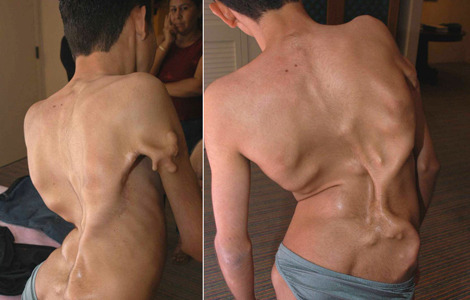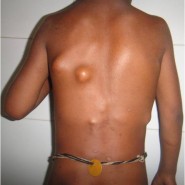
Fibrodysplasia ossificans progressiva (FOP), is a rare, inherited disorder characterized by progressive fibrosing and ossification of muscles, tendons, fascia, aponeurosis and ligaments of multiple sites that is disabling and ultimately fatal. The process of heterotopic ossification starts between 2 and 5 years old.
It should not be confused with myositis ossificans circumscripta, which is usually post traumatic.
Extra-skeletal bone formation causes progressive loss of mobility as the joints become affected. Inability to fully open the mouth may cause difficulty in speaking and eating. Over time, people with this disorder may experience malnutrition due to their eating problems. They may also have breathing difficulties as a result of extra bone formation around the rib cage that restricts expansion of the lungs.
Any trauma to the muscles of an individual with fibrodysplasia ossificans progressiva, such as a fall or invasive medical procedures, may trigger episodes of muscle swelling and inflammation (myositis) followed by more rapid ossification in the injured area. Flare-ups may also be caused by viral illnesses such as influenza.

SIGNS AND SYMPTOMS
The hallmark symptom of fibrodysplasia ossificans progressiva (FOP) is a malformation of a newborn's big toe. This malformation, which is apparent at birth, consists of a short big toe with an abnormal turning of the toe called a valgus deviation.
During early childhood, most of those with FOP form painful fibrous nodules, or tumor-like swellings, over the neck, back and shoulders. These nodules often develop after a child experiences some sort of trauma to the body, such as a bump or fall. Episodes also can occur without any warning or may not occur at all. In most cases, the nodules transform into bone during a process known as heterotopic ossification.
When the body starts to generate new bone, the patient usually experiences a painful flare-up. Tissue swelling, joint stiffness and serious discomfort can occur. Some may have a low-grade fever. Flare-ups can last as long as six to eight weeks. The disease then progresses along the trunk and limbs of the body. These lesions slowly replace the body's muscles with normal-looking bone.



CAUSE
FOP is caused by an autosomal dominant allele on chromosome 2q23-24. But most cases are caused by spontaneous mutation in the gametes.A mutation in the gene ACVR1 (also known as activin-like kinase 2 [ALK-2]) is responsible for the disease. ACVR1 encodes activin receptor type-1, a BMP type-1 receptor. The mutation causes substitution of codon 206 from arginine to histidine in the ACVR1 protein. This substitution causes abnormal activation of ACVR1 leading to the transformation of connective tissue and muscle tissue into a secondary skeleton. This causes endothelial cells to transform to mesenchymal stem cells and then to bone.
GENETICS
FOP or Stone Man Syndrome is an autosomal dominant disorder that affects individuals who are heterozygous with a homozygous recessive partner, therefore their children will have 50% chance of being affected. Two affected individuals can produce unaffected children. The phenotypes of those who are homozygous dominant have more severe effects compared to those with heterozygous phenotype.
The gene that causes ossification is normally deactivated after a fetus' bones are formed in the womb, but in patients with FOP, the gene keeps working. Aberrant bone formation in patients with FOP occurs when injured connective tissue or muscle cells at the sites of injury or growth incorrectly express an enzyme for bone repair during apoptosis (self-regulated cell death), resulting in lymphocytes containing excess bone morphogenetic protein 4 (BMP4) provided during the immune system response. The bone that results occurs independently of the normal skeleton, forming its own discrete skeletal elements. These elements, however, can fuse with normal skeletal bone.Interestingly, the diaphragm, tongue, and extra-ocular muscles are spared in this process, as well as cardiac and smooth muscle. Since the incorrect enzyme remains unresolved within the immune response, the body continues providing the incorrect BMP4-containing lymphocytes. BMP4 is a product that contributes to the development of the skeleton in the normal embryo.
Because the disease is so rare, the symptoms are often misdiagnosed as cancer or fibrosis. This leads doctors to order biopsies, which can actually exacerbate the growth of these lumps.


TREATMENT
There is no known cure for FOP. Attempts to surgically remove the bone result in more robust bone growth. While under anesthesia, patients with FOP may face problems, which include difficulties with intubation, restrictive pulmonary disease, and changes in the electrical conduction of the heart. Activities that increase the risk of falling should be avoided, as injuries from falling can provoke the growth of bone.

SOURCE: radiopaedia.org
ghr.nlm.nih.gov
wikipedia.org
ucsfbenioffchildrens.org
Thank you very Steady info ... hopefully more successful.
ReplyDeletePengobatan Herbal Jantung Bengkak